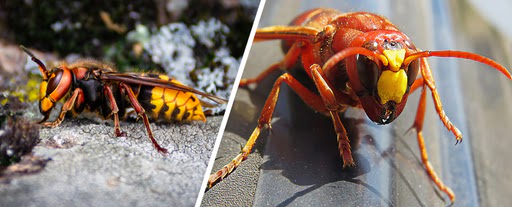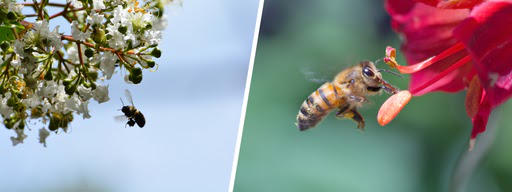Asian giant hornets, also known as murder hornets, are a type of wasp that are primarily found in Asian countries but have recently been discovered in other parts of North America. While they do not pose a threat to humans unless provoked, they are a significant danger to bee populations as bees are their main source of food.
I’m sure many of you have heard about Asian giant hornets, also known as murder hornets, in the news recently. You may have come across articles about them but didn’t pay much attention due to more pressing news about the pandemic. Perhaps you briefly read about them but didn’t fully understand, or maybe you’ve never even heard of these creatures before.
Regardless of your knowledge, we’re here to provide you with more information about these unique and fearsome insects.
What Are Asian Giant Hornets And What Do They Look Like?
Hornets are a type of wasp, and Asian giant hornets are the largest species of hornets. Adult workers typically grow to less than 2 inches in size, while adult queens can reach nearly 2 inches. They have a distinct orange-yellow head with yellow and brown bands on their abdomen, making them easily distinguishable from other hornet species.
 Size and appearance of Asian Giant hornet in comparison to other hornet species
Size and appearance of Asian Giant hornet in comparison to other hornet species
These hornets have prominent cheeks on either side of their head, giving them a larger appearance than other hornet species. Their cheeks are crucial for moving their large mandibles to subdue their prey.
 Despite their painful sting, they are very attractive! (Photo Credit: Elina Litovkina & AyhanTuranMenekay/Shutterstock)
Despite their painful sting, they are very attractive! (Photo Credit: Elina Litovkina & AyhanTuranMenekay/Shutterstock)
Asian giant hornets typically build their nests underground, which sets them apart from other wasp species that usually build their hives on trees. However, like other species, they fiercely defend their nests.
Where Are Asian Giant Hornets Found?
While this species prefers temperate regions, sightings have also been reported in subtropical areas. As their name suggests, Asian giant hornets are native to Asia, ranging from Russia, Japan, and China to Nepal and Myanmar. Recently, they have also been found in parts of Western Europe, Canada, and certain regions of America. However, scientists have yet to determine how they ended up in these countries.
The majority of hornets are workers and cannot reproduce or start new hives independently. It is possible that fertilized female hornets were transported from one country to another via airplanes or ship cargo and then spread from there.
How Do Asian Giant Hornets Hunt for Food?
Asian giant hornets can forage up to eight kilometers from their nest in search of food. They primarily feed on other insects, such as bees and beetles. When it comes to finding resources, these hornets are highly competitive and aggressive. Researchers have observed that they gather around tree sap and prevent others from accessing it.
This particular species of hornet has unique hunting methods. Individual hornet workers have been observed attacking honey bees outside their beehives. They kill the bees by removing their heads and then chewing on them until they turn into a paste. This paste is then taken back to the hornet’s nest to feed the larvae.
A single Asian giant hornet is capable of taking on multiple bees by itself. However, this is just one way these hornets prey on bees. Their more well-known method is called slaughter. In this strategy, 10-20 Asian giant hornets coordinate an attack on a bee colony, tearing apart the bees’ heads and continuing the attack until there are no guard bees left to defend the nest. If any worker bees survive until nightfall, the hornets return the next day to finish the job and empty the nest of adult bees. Once all the bees have been killed, the hornets enter the nest and retrieve the bee larvae to feed their own young.
The nickname “Murder Hornets” comes from the way these hornets attack their prey, particularly honey bees, to feed their offspring. Just 15-30 hornets are enough to wipe out an entire colony of 30-50,000 honey bee workers in a matter of hours. The origin of the nickname is still unclear, but some entomologists speculate that it originated in Japan, where the sting of the hornet is said to be as painful as murder.
While Asian giant hornets are not a significant threat to humans, they can be deadly if provoked. In 2013, a swarm of giant hornets killed 42 people and injured 1600 in rural China. However, their biggest threat is to bees, which indirectly impacts humanity. Bees play a crucial role in pollinating the majority of the food we eat, so without them, we would be missing out on important nutrients.
 A world without bees is a world in which humans cannot survive! (Photo Credit: Melissa Grisham & sumikophoto/Shutterstock)
A world without bees is a world in which humans cannot survive! (Photo Credit: Melissa Grisham & sumikophoto/Shutterstock)
Giant hornets pose a significant threat to bees, as they have the ability to completely destroy an entire bee colony or hive in just a few hours. Certain bee species, like Asian honey bees, have developed defensive strategies to protect themselves and their hives. For example, Asian honey bees gather together and vigorously vibrate their wings, producing carbon dioxide and heat, which ultimately suffocates the invading hornets. Unfortunately, not all bee species have acquired these same defense mechanisms. As a result, when a hornet attacks their hive, they are defenseless and easily eradicated.
I trust that this article has provided you with a better understanding of Asian giant hornets. However, if you encounter one in the future, it is important to refrain from touching it and maintain a safe distance. While they may have been unfairly labeled as “murderers,” their stings can still inflict considerable pain!
